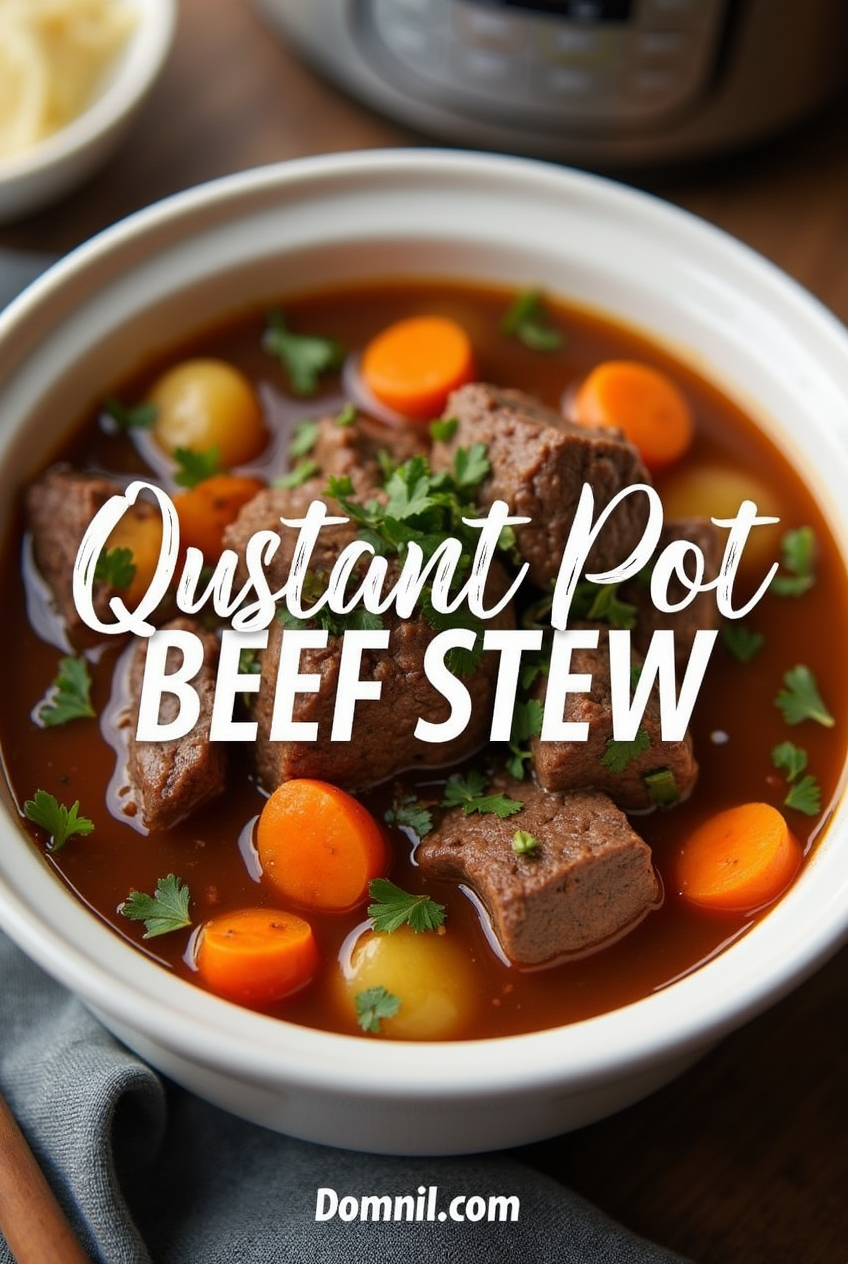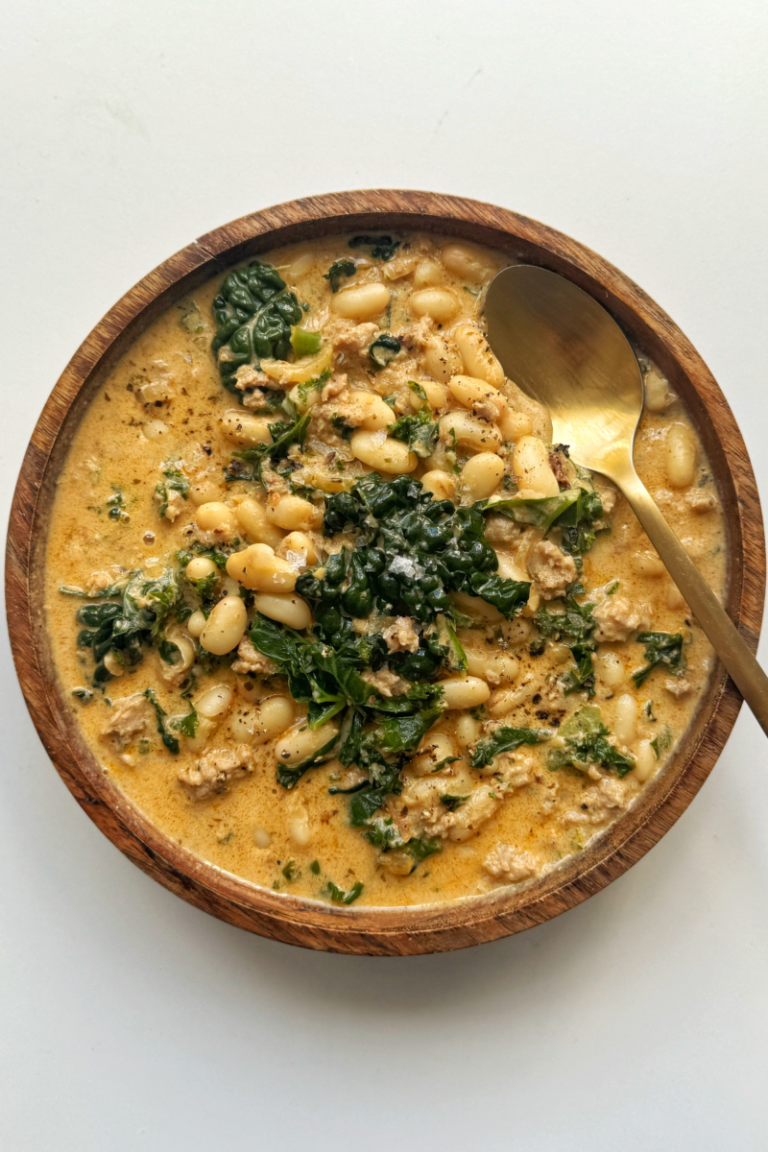Quick Instant Pot Beef Stew
Introduction to Instant Pot Beef Stew
Why Choose Instant Pot for Beef Stew?
If you’re the kind of person who craves a rich, hearty beef stew but doesn’t have hours to spend in the kitchen, the Instant Pot is your new best friend. Traditional beef stew can take several hours to simmer and develop its depth of flavor, but with the Instant Pot, you can enjoy that same comforting experience in a fraction of the time.
Why the Instant Pot? It’s a game changer for busy weeknights and even lazy Sundays. This multi-functional kitchen gadget combines several appliances in one – pressure cooker, slow cooker, sauté pan, and more – which streamlines the whole cooking process. When it comes to beef stew, pressure cooking is particularly amazing because it tenderizes even tougher cuts of beef incredibly quickly while locking in all those deep, savory flavors.
What’s better is that everything cooks in one pot. That means less cleanup, more efficiency, and one seriously delicious meal at the end of it. It’s perfect for feeding a family, meal prepping for the week, or impressing guests with your seemingly magical cooking skills.
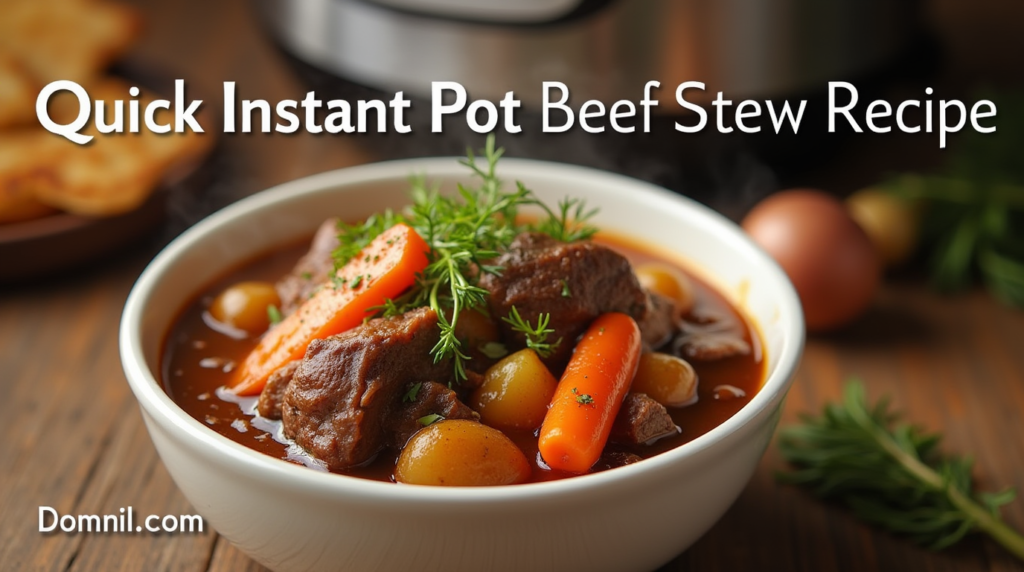
Table of Contents
The Appeal of a Quick and Hearty Meal
Beef stew hits differently—it’s the culinary equivalent of a warm hug. Especially on colder days or after a long shift, digging into a bowl of tender beef, soft potatoes, and perfectly cooked veggies feels like absolute heaven. But usually, this level of comfort food means hours in the kitchen. Not anymore.
With this quick Instant Pot recipe, you’re getting all the classic stew goodness—rich broth, melt-in-your-mouth beef, and hearty vegetables—but in under an hour from prep to plate. That’s the magic of pressure cooking. You’re not sacrificing flavor for speed; you’re just using science to your advantage.
And if you’re trying to stretch a budget, this stew makes use of affordable ingredients that feed a crowd. So, whether you’re short on time, money, or both, this dish has your back.
Ingredients You’ll Need
Essential Ingredients
Here’s a quick list of the basic ingredients you’ll need to get your Instant Pot beef stew started:
- Beef Chuck Roast or Stew Meat – about 2 lbs, cut into 1 to 2-inch cubes. Chuck roast works best for its marbling and flavor.
- Yellow Onion – diced.
- Garlic – minced (fresh is best!).
- Carrots – peeled and cut into thick rounds.
- Potatoes – Yukon gold or red potatoes are ideal, chopped into large chunks.
- Celery – sliced.
- Beef Broth – low-sodium preferred.
- Tomato Paste – adds richness and depth.
- Worcestershire Sauce – for umami magic.
- Bay Leaves & Thyme – classic stew herbs.
- Salt & Pepper – always to taste.
- Olive Oil or Butter – for sautéing.
These are your building blocks. Together, they create a broth that’s bold and beefy, veggies that are soft but not mushy, and meat so tender it falls apart at the touch of a fork.
Optional Add-ins for Extra Flavor
Want to take things up a notch? Try these:
- Red Wine – swap out ½ cup of the broth for wine to add richness.
- Mushrooms – for an earthy touch.
- Green Peas – stirred in at the end for a pop of color and sweetness.
- Paprika or Smoked Paprika – adds depth.
- A Dash of Balsamic Vinegar – a secret ingredient for brightness.
Customizing the flavor is easy with this stew. Use what you have or elevate it with a few special extras—it’s flexible, forgiving, and always tasty.
Substitutions for Dietary Needs
No beef? No problem. Try these swaps:
- Chicken or Turkey Thighs – if you prefer poultry.
- Plant-Based Meat Substitutes – for a vegetarian or vegan version.
- Sweet Potatoes – instead of white potatoes for a paleo-friendly stew.
- Gluten-Free Worcestershire Sauce – if you’re avoiding gluten.
This recipe is super versatile, so feel free to tweak it based on what you need—or what’s hanging out in your fridge.
Preparation Tips Before Cooking
Selecting the Right Cut of Beef
Not all beef is created equal when it comes to stew. The best option? Chuck roast. It’s affordable, marbled with fat, and becomes meltingly tender under pressure. Other good choices include bottom round, brisket, or any stew-designated cuts you find at the butcher.
Avoid lean cuts like sirloin—they’ll dry out and turn tough in the pressure cooker. Remember, a little fat is your friend here; it renders down during cooking, giving the stew its deep, rich flavor and luscious texture.
Pro tip: cut your beef into even-sized chunks so they cook uniformly. And if you’ve got time, pat them dry before browning—that step helps you get a beautiful crust and boosts flavor tenfold.
Prepping Your Vegetables Efficiently
When you’re in a rush, how you chop your veggies matters. Bigger chunks of carrot and potato hold up better under pressure, so avoid cutting them too small unless you like them super soft. A rough 1.5-inch cube is the sweet spot.
You can even prep your veggies a day ahead and store them in the fridge—just keep the potatoes in water so they don’t oxidize and turn brown.
If you’re using garlic, always go fresh. It gives the stew a much brighter and more aromatic punch compared to jarred or powdered garlic.
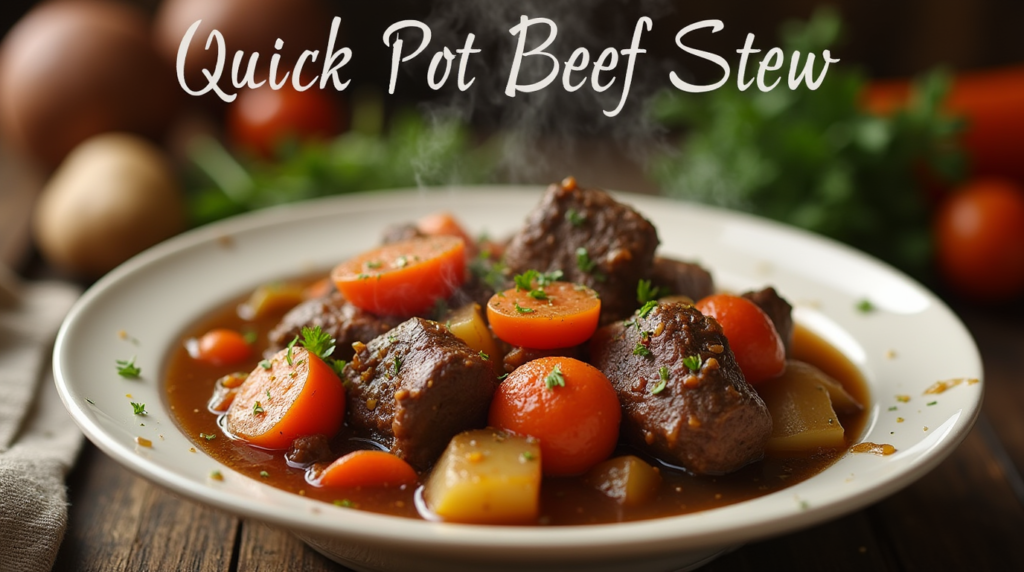
Step-by-Step Cooking Instructions
Sautéing for Extra Flavor
Start by using the Sauté function on your Instant Pot. Add a bit of oil and sear your beef chunks in batches. Don’t overcrowd the pot—this isn’t a rush job. You want a good crust on each piece, which adds tons of depth to the stew.
After browning the beef, set it aside and sauté your onions, garlic, and celery. This deglazes the pot and lifts all that flavorful browned goodness from the bottom. Add a splash of beef broth to help loosen anything stuck—that’s where the flavor lives.
Once your veggies are softened and fragrant, stir in your tomato paste and cook it down for a minute or two to eliminate the raw taste.
Then, it’s time to bring everything together in the pot—the beef, broth, Worcestershire, carrots, potatoes, bay leaves, and thyme.
Pressure Cooking for Speed and Tenderness
Once all your ingredients are in the Instant Pot, it’s time to let the magic happen. Lock the lid into place and ensure the valve is set to Sealing. Set your Instant Pot to Pressure Cook (or Manual) on High Pressure for 35 minutes.
Why 35 minutes? That’s the sweet spot for chuck roast to break down and become fork-tender while allowing all the flavors to meld beautifully. Don’t worry if it seems like a long time for a pressure cooker—that’s still a huge time saver compared to the 2–3 hours you’d spend with a stovetop stew.
After the cooking cycle finishes, don’t open it right away. Let the pressure naturally release for about 10 to 15 minutes, then switch the valve to Venting for a quick release of any remaining steam. This natural release phase helps the meat stay juicy and prevents a mess from spewing liquid everywhere.
Once the lid unlocks, remove it carefully—steam can burn. You’ll be greeted with the irresistible aroma of rich, meaty stew that looks like it’s been simmering all day.
Natural vs Quick Release – Which to Use?
You might wonder: why not just use Quick Release and dive right in?
Here’s the deal: Quick Release drops the pressure rapidly, which can result in tougher meat if it’s not quite ready. It also tends to cause more liquid splatter, especially in recipes with a lot of broth.
On the flip side, Natural Release allows the pressure to gradually reduce inside the pot, which lets the meat fibers relax. That means more tender bites and fewer spills. For beef stew, using at least a 10-minute natural release is the best of both worlds—efficient and flavorful.
If you’re in a rush, you can do 10 minutes natural, then finish with a Quick Release. That way, you save time without compromising texture.
Tips for Perfect Instant Pot Beef Stew
Thickening the Stew
Once the lid comes off, your stew will look and smell amazing, but you might notice the broth is a bit thinner than you want. No biggie—this is totally normal with pressure cooking.
To thicken it up, mix 1–2 tablespoons of cornstarch with cold water (this is your slurry). Stir it into the stew while the pot is still hot, and turn the Sauté function back on. Let it bubble for a few minutes, stirring occasionally, until the broth reaches your desired consistency.
If you prefer a more rustic approach, you can mash a few potato chunks against the side of the pot and stir. It’ll naturally thicken the stew without adding anything extra.
Another option? Let it rest. As the stew cools slightly, it thickens on its own—so if you’re patient, it might not need much adjustment at all.
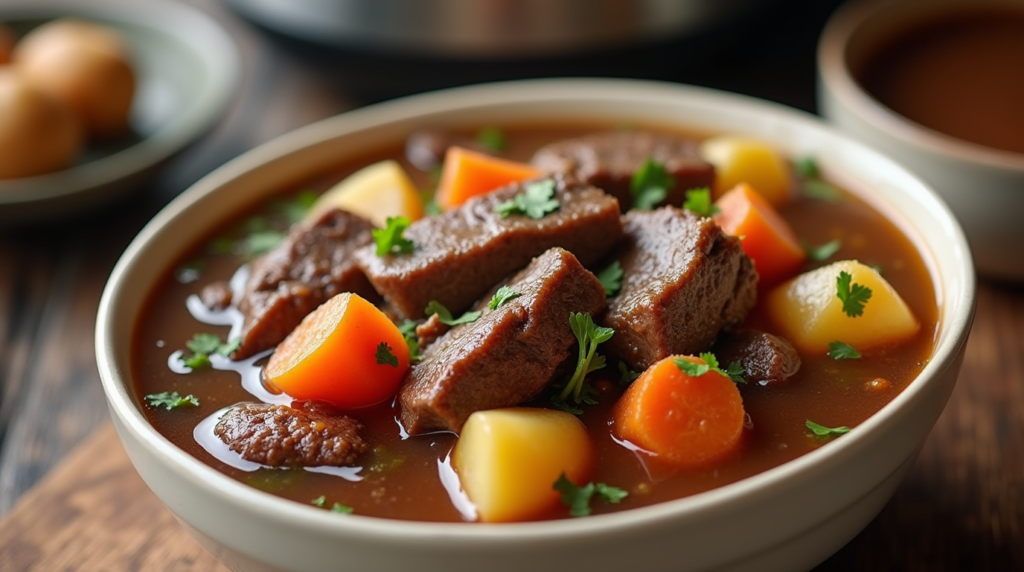
Adjusting Seasonings After Cooking
The Instant Pot seals in flavor, but sometimes it needs a little final touch. Once your stew is done, give it a taste and tweak as needed:
- Too bland? Add a pinch more salt, a splash of Worcestershire sauce, or a hit of balsamic vinegar.
- Needs brightness? A squeeze of lemon or a handful of fresh chopped parsley can work wonders.
- Too thick? Stir in a bit more broth or water to loosen it up.
Don’t forget to fish out those bay leaves before serving—they’ve done their job and no one wants to bite into one.
Avoiding Common Mistakes
Even the simplest recipes can go sideways without a few pro tips. Here are some common mistakes to dodge:
- Overcrowding the pot when searing – It steams the beef instead of browning it. Brown in batches.
- Skipping the deglazing step – Those browned bits stuck to the pot are pure flavor. Don’t let them go to waste.
- Cutting veggies too small – Especially potatoes and carrots. They’ll turn mushy after pressure cooking.
- Adding peas or delicate greens too early – They’ll overcook. Always stir these in after pressure cooking.
If you stick to these basics, your stew will turn out consistently delicious every time.
Serving Suggestions
Best Side Dishes to Pair With
While this beef stew is a complete meal in itself, a few tasty sides can take it to the next level. Here are some ideas:
- Crusty Bread or Dinner Rolls – Perfect for soaking up that luscious broth.
- Mashed Potatoes – Serve the stew right on top for double comfort food.
- Buttered Noodles – Especially egg noodles, which pair beautifully with the rich sauce.
- Rice or Quinoa – Great if you want to stretch the stew further and soak up every drop.
- Steamed Greens – Like kale, spinach, or broccoli to lighten things up.
Don’t forget a glass of red wine if that’s your thing—it complements the rich, meaty flavors like nothing else.
Garnish Ideas for Presentation
Want to make your beef stew look as good as it tastes? Here are a few quick garnishes to sprinkle on before serving:
- Fresh Parsley or Chives – Adds color and a pop of freshness.
- Grated Parmesan Cheese – For a rich umami kick.
- A Dollop of Sour Cream – Not traditional, but surprisingly delicious.
- Crushed Red Pepper Flakes – If you like a little heat.
Presentation might not seem important for comfort food, but a beautiful bowl makes the whole experience feel a bit more special.
Storing and Reheating Leftovers
Refrigeration and Freezer Tips
One of the best things about beef stew? It tastes even better the next day. The flavors continue to meld in the fridge, making leftovers a total win.
Refrigeration Tips:
- Let your stew cool to room temperature before storing.
- Transfer it into an airtight container.
- It’ll stay fresh in the fridge for up to 4–5 days.
Freezing Tips:
- Want to stash some for later? Stew freezes beautifully.
- Portion it into individual containers or freezer bags. This makes reheating easier and faster.
- Label with the date and use within 3 months for best flavor and texture.
Avoid freezing the stew with potatoes if you can—they tend to get grainy when thawed. If you’re meal prepping for the freezer, consider adding the potatoes fresh when you reheat the stew later.

Best Way to Reheat Without Losing Flavor
When it’s time to reheat, you want to preserve that deep, hearty flavor without drying out the meat or turning the veggies to mush.
Microwave: Transfer a portion to a microwave-safe bowl, cover loosely, and heat in 1-minute intervals, stirring between rounds. This ensures even heating and prevents overcooking.
Stovetop: Pour your stew into a saucepan and reheat over medium-low heat, stirring occasionally. You can add a splash of broth or water if it’s too thick.
Instant Pot: Yes, you can even reheat in the Instant Pot. Use the Sauté function to warm it gently or use the Steam setting with a splash of liquid and a glass lid.
Avoid boiling the stew aggressively—that’ll toughen the meat and ruin all your hard work.
Variations on the Classic Recipe
Low-Carb or Keto Version
Trying to keep it low-carb or keto? No problem. You can still enjoy all the cozy goodness of beef stew without the carbs.
- Swap out potatoes for cauliflower florets or turnips.
- Skip the flour or cornstarch for thickening. Instead, reduce the broth using the Sauté function or add a touch of xanthan gum.
- Use bone broth instead of standard beef broth for extra nutrients and richness.
You still get that tender beef and savory broth, just with fewer carbs—perfect for a keto meal plan.
Gluten-Free Options
Good news: this beef stew is naturally gluten-free as long as you skip the flour and use gluten-free alternatives where needed.
- Use cornstarch or arrowroot powder for thickening instead of flour.
- Make sure your Worcestershire sauce and broth are labeled gluten-free. Some brands sneak wheat into the mix.
- Double-check seasonings or pre-made spice blends for hidden gluten sources.
This way, everyone at the table can dig in without worry.
Vegetarian Twist (Using Plant-Based Meat)
Yes, you can still make a hearty “beef” stew without the beef.
- Use plant-based beef alternatives like Beyond Meat or jackfruit for that meaty texture.
- Amp up the umami with soy sauce, miso paste, or mushrooms.
- Substitute vegetable broth for beef broth, and keep the veggies chunky.
Add lentils or beans for extra protein, and boom—you’ve got a vegetarian-friendly stew that’s just as satisfying.
Nutritional Benefits of Beef Stew
Protein and Vitamin-Rich
Beef stew isn’t just comfort food—it’s nutrient-dense and surprisingly balanced when made right.
- Protein: Chuck roast is rich in high-quality protein, essential for muscle repair and energy.
- Iron & Zinc: Beef is a top source of these minerals, which support your immune system and energy levels.
- Vitamin A & C: Carrots, potatoes, and celery contribute essential vitamins for vision, skin health, and immunity.
- Collagen: If using bone-in cuts or bone broth, you’ll also benefit from collagen, which supports joint and skin health.
It’s like a multivitamin in a bowl—but way more delicious.
How It Fits Into a Balanced Diet
Beef stew is naturally balanced in macros—protein from beef, carbs from vegetables, and healthy fats if you use olive oil or butter. You can adjust the ratios depending on your dietary goals:
- Want more fiber? Toss in peas, kale, or lentils.
- Going low-carb? Swap starchy vegetables for cauliflower or radishes.
- Need more calories? Serve over rice or noodles.
It’s flexible, filling, and fantastic for fueling your body.
Why This Recipe Works So Well
Flavor Development in Short Time
The Instant Pot’s high-pressure magic means you get hours of flavor in under one hour. That deep, slow-simmered taste comes from pressure-infused cooking, where herbs, aromatics, and meat mingle intensely in a sealed environment.
You’re also building flavor in layers—browning the meat, sautéing the aromatics, deglazing the pot—all in one place. It’s not just a dump-and-go dish; it’s a culinary shortcut that doesn’t skimp on complexity.
Convenience and Consistency
This beef stew recipe is consistent every time—no matter your cooking skill. Whether you’re a beginner or seasoned home chef, the Instant Pot ensures evenly cooked veggies, tender meat, and a rich, balanced broth.
Plus, you’re saving on dishes. Everything happens in one pot. Cleanup? Minimal. Effort? Low. Reward? Maximum.
Tools you’ll need to prepare Quick Instant Pot Beef Stew:
| Tool | Purpose |
|---|---|
| Instant Pot | Main cooking appliance for pressure cooking the stew. |
| Cutting Board | For chopping vegetables and cutting beef. |
| Sharp Chef’s Knife | Essential for clean, even cuts. |
| Mixing Bowls | For prepping and holding chopped ingredients. |
| Tongs or Slotted Spoon | To brown meat and remove it without splashing. |
| Wooden Spoon/Spatula | For stirring and deglazing the pot. |
| Measuring Cups & Spoons | For accurate ingredient measurement. |
| Ladle | For serving the stew into bowls. |
| Peeler | To peel carrots and potatoes easily. |
| Small Bowl | For mixing cornstarch slurry (optional thickener). |
| Storage Containers | For refrigerating or freezing leftovers. |
Final Thoughts
Quick Instant Pot Beef Stew is more than just a shortcut to dinner—it’s your go-to meal for when you want comfort, convenience, and nutrition all in one bowl. It’s endlessly customizable, budget-friendly, and guaranteed to impress whether you’re cooking for family, friends, or just yourself. From the savory aroma filling your kitchen to the last spoonful of stew soaked up with bread, this dish delivers every time.
So go ahead—grab your Instant Pot, a few simple ingredients, and dig into a meal that’s as satisfying to make as it is to eat.
FAQs
Can I make this with frozen beef?
Yes, but skip the sautéing step and increase the cook time by 10 minutes. It will still turn out tender and flavorful.
How long does beef stew last in the fridge?
Stored properly in an airtight container, it will last 4–5 days in the refrigerator.
What’s the best wine to use in beef stew?
A dry red wine like Cabernet Sauvignon or Merlot adds richness. Don’t use anything too sweet or overly fruity.
Can I double the recipe in my Instant Pot?
Absolutely, as long as you don’t fill past the “Max Fill” line. Keep the same cook time—pressure cooking adjusts to volume automatically.
Is it okay to skip browning the meat?
Yes, but you’ll miss out on that extra depth of flavor. If you’re short on time, it’s still delicious without it.

